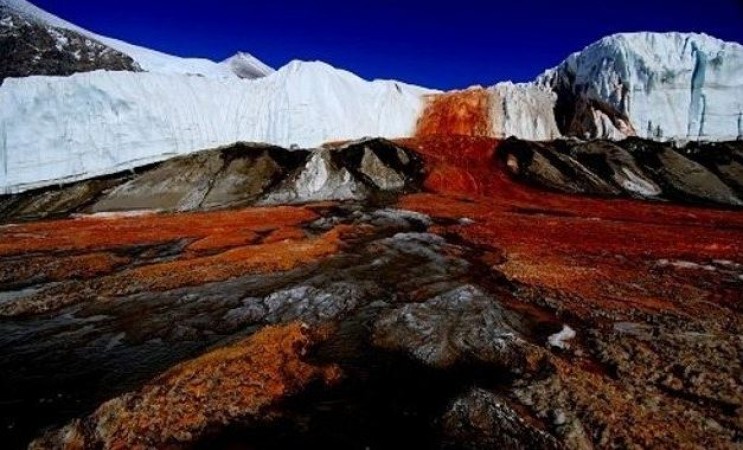
Introduction
In the remote and desolate region of Antarctica, there exists a natural wonder that both mesmerizes and perplexes scientists and explorers alike. Known as Blood Falls, this eerie waterfall captures attention with its striking blood-red appearance. Located in the McMurdo Dry Valleys, one of the coldest and driest places on Earth, this enigmatic phenomenon has been a subject of fascination and study for decades.
The Discovery of Blood Falls
Blood Falls was first discovered by Griffith Taylor, an Australian geologist, during the 1911-1912 Terra Nova Expedition led by Captain Robert Falcon Scott. As the expedition explored the Taylor Glacier, Taylor stumbled upon the peculiar sight of a waterfall flowing with blood-red water, staining the pristine white ice.
The Geological Process Behind the Red Water
The mesmerizing red color of the water at Blood Falls is a result of iron oxide, commonly known as rust. Underneath the Taylor Glacier, there lies a vast reservoir of salty, iron-rich water. As this subglacial water interacts with the oxygen-rich atmosphere, iron in the water oxidizes, giving it the striking red hue.
Unraveling the Mystery: How Does the Water Stay Liquid?
One of the most intriguing aspects of Blood Falls is how the water manages to remain liquid despite the extreme cold temperatures in Antarctica. Scientists have discovered that the water remains in a liquid state due to a combination of high salt content and pressure from the glacier above. This unique geological configuration prevents the water from freezing, allowing it to flow as a waterfall.
The Significance of Blood Falls
Blood Falls provides scientists with a valuable opportunity to study the Earth's past and gain insights into the possibility of life in extreme environments. The iron-rich subglacial water and the microbial life it sustains offer a glimpse into ancient ecosystems and the potential for life in similar extreme conditions on other planets.
The Microbial Life in the Water
The red waters of Blood Falls harbor a diverse community of microorganisms that have adapted to survive in this harsh environment. These microbes have evolved unique strategies to cope with the high salt concentration and lack of sunlight. They rely on chemosynthesis, a process where they convert chemicals such as iron and sulfur into energy, instead of relying on sunlight like most other organisms.
Environmental Implications
Studying Blood Falls and its microbial life can provide valuable insights into the resilience of life on Earth and the potential for life on other icy worlds in our solar system. The extremophiles found in Blood Falls challenge our understanding of the limits of habitability and expand our knowledge of how life can persist in seemingly uninhabitable environments.
Scientific Research and Studies
Scientists from various disciplines have been conducting research and studies at Blood Falls to better understand its geological and biological complexities. They use cutting-edge technologies, including remote sensing, ice core sampling, and DNA analysis, to unlock the secrets held within the red waters. These studies contribute to our broader understanding of Earth's history and the possibilities of life beyond our planet.
Exploring Blood Falls
While Blood Falls is located in an inhospitable environment, it has become a point of interest for explorers and adventurers. Scientific expeditions and guided tours allow intrepid individuals to witness the awe-inspiring sight of the blood-red waterfall firsthand. However, strict regulations are in place to protect this delicate ecosystem and ensure minimal disturbance to the unique microbial life.
The Beauty and Uniqueness of Blood Falls
Beyond its scientific significance, Blood Falls possesses a haunting beauty that captivates all who witness it. The stark contrast of the red water against the white ice and the surrounding barren landscape creates a surreal and ethereal ambiance. It serves as a reminder of the wonders that exist in our world, even in the most extreme and unexpected places.
Conclusion
Blood Falls remains an enigmatic natural phenomenon that continues to intrigue scientists and spark the imagination of all who learn of its existence. With its eerie blood-red waters, thriving microbial life, and implications for the search for extraterrestrial life, this captivating waterfall serves as a testament to the resilience and adaptability of life on Earth. Exploring Blood Falls unveils the hidden mysteries of our planet and offers glimpses into the secrets of the universe.
India's Space Program Soars, ISRO Inspires Scientific Advancement